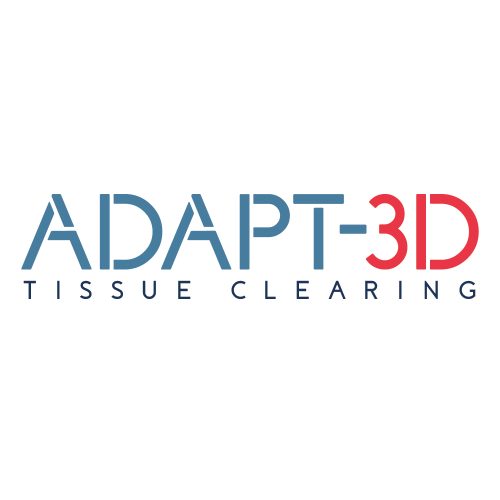ADAPT-3D™ Decalcification Buffer
- -
- -
Product DetailsComponents The ADAPT-3D™ Decalcification Buffer is formulated with a proprietary blend of chelating agents and mild acids optimized for rapid and gentle removal of mineral deposits without compromising tissue integrity. Storage and Handling Store the buffer at room temperature in a dry environment, ensuring it is protected from moisture and temperature fluctuations. Do not freeze the product; when stored as directed, it maintains full potency and stability for up to six months. Country of Origin USA Shipping Room temperature via Ground Shipping or 2-Day Air. DescriptionBackground Effective 3D fluorescence imaging of biological specimens often requires rendering tissues optically transparent, a process broadly known as tissue clearing. In many clearing workflows, soft tissues (e.g., brain, liver, intestine) are treated to remove lipids and other light-scattering components. However, when working with hard or calcified tissues—such as bone, teeth, or mineralized cartilage—additional steps must be taken to eliminate calcium deposits that would otherwise prevent uniform clearing and obscure fluorescence signals. The ADAPT-3D™ Decalcification Buffer addresses this challenge by gently solubilizing mineral content without damaging the underlying tissue architecture or quenching fluorophores. During the decalcification step, specimens are immersed in the ADAPT-3D™ Decalcification Buffer, which contains chelating agents and mild acids designed to dissolve calcium salts. This process typically occurs prior to lipid removal, ensuring that the dense mineral matrix is removed first so that subsequent permeabilization and delipidation steps can proceed more evenly. By preserving cellular and extracellular structures—including collagen networks, vascular channels, and embedded antigens—this buffer prepares hard tissues for downstream immunostaining, delipidation, and refractive index matching. Once decalcification is complete, the tissue is washed to eliminate any remaining buffer components, then subjected to the rest of the ADAPT-3D™ clearing protocol (e.g., partial delipidation, full clearing, immunostaining). Because mineralized tissues tend to scatter light more than soft tissues, failing to decalcify can lead to uneven transparency, reduced antibody penetration, and poor imaging depth. In contrast, properly decalcified samples achieve improved optical clarity, allowing researchers to visualize cellular architecture and protein localization in three dimensions—whether examining bone marrow niches, osteocyte lacunae, or neural pathways that traverse mineralized regions. By integrating the ADAPT-3D™ Decalcification Buffer into the workflow, researchers can confidently include hard tissues in their 3D imaging studies, unlocking new opportunities to study developmental biology, pathologies of the skeletal system, and the interface between soft and hard tissues. Directions for Use Place the samples in a glass container filled with an excess volume of ADAPT-3D™ Decalcification Buffer (Catalog #B670) at room temperature to ensure complete immersion. Replace the buffer with fresh solution each day to maintain optimal decalcification conditions and prevent accumulation of dissolved minerals. Continue this daily buffer exchange until the tissue becomes soft to the touch, indicating complete decalcification. Each investigator should determine their own optimal working dilution for specific applications. See directions on lot specific datasheets, as information may periodically change. Hazard Description Handle the ADAPT-3D™ Decalcification Buffer with care in your laboratory. Always wear appropriate personal protective equipment, including gloves, lab coat, and safety goggles. For comprehensive safety, handling, storage, and emergency procedures, refer to the product’s Safety Data Sheet (SDS). Manufacturing StandardsAt Leinco Technologies, our buffer manufacturing process is conducted in an ISO 13485–certified facility in St. Louis, Missouri, ensuring that every reagent meets the most stringent quality and performance criteria. From formulation through fill–finish, we employ rigorous in‐process controls and lot‐release testing—verifying pH, conductivity, sterility, and consistency—to guarantee that each buffer delivers reliable, reproducible results. This comprehensive quality system underpins our suite of high‐performance reagents, supporting assay developers in creating sensitive, robust immunoassays and advanced 3D imaging workflows. Related Protocols3D IHC |
 Products are for research use only. Not for use in diagnostic or therapeutic procedures.
Products are for research use only. Not for use in diagnostic or therapeutic procedures.


